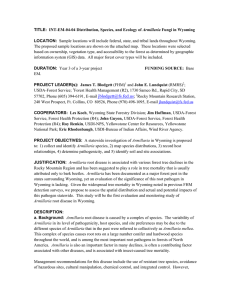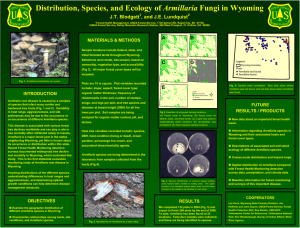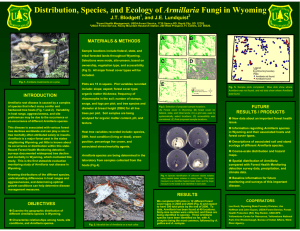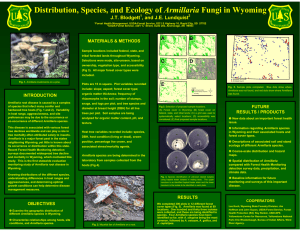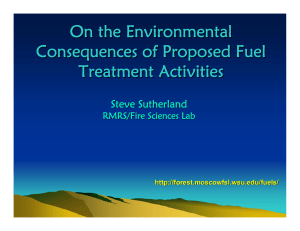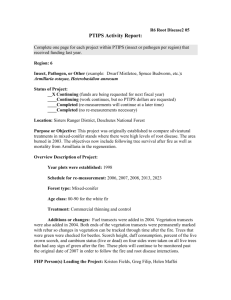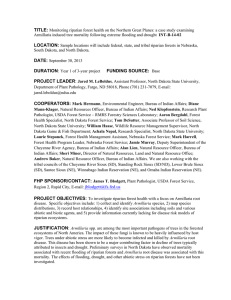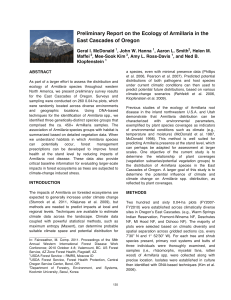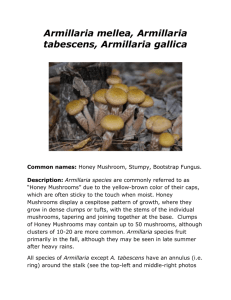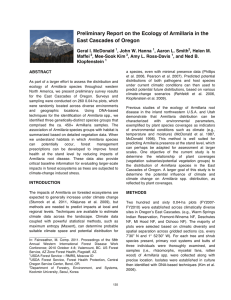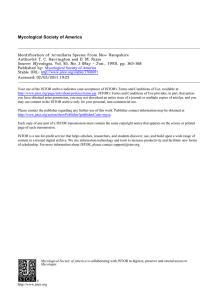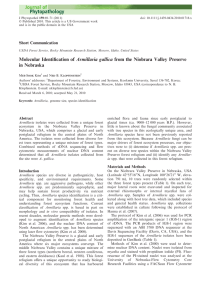Number: INT-EM-04-04 TITLE: LOCATION:
advertisement
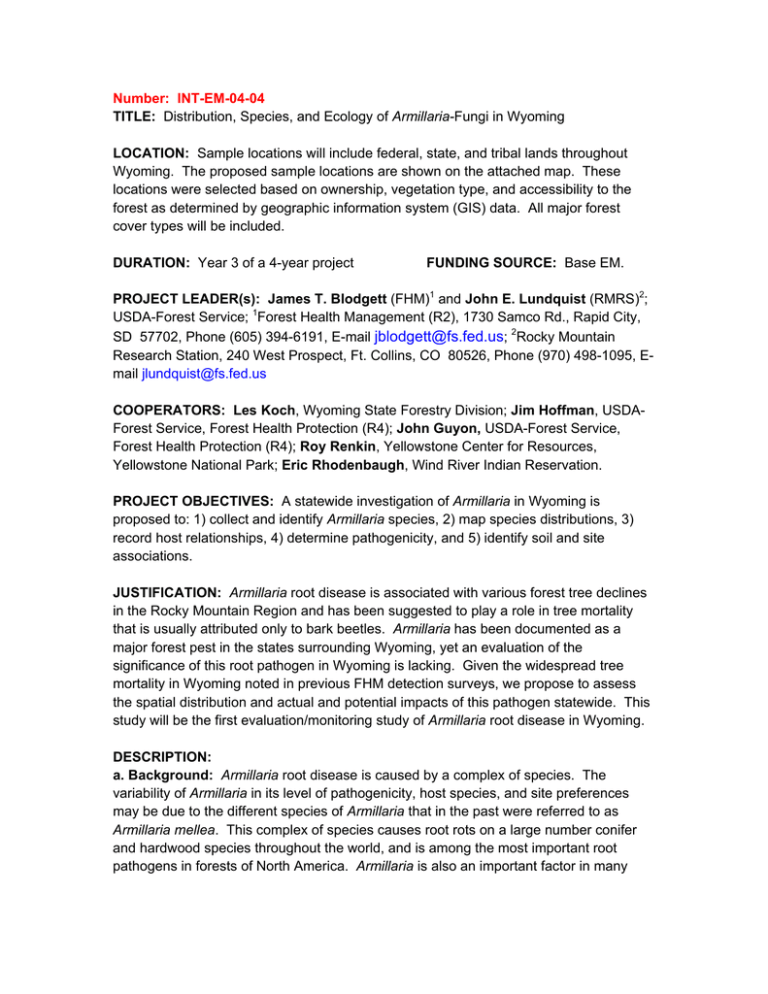
Number: INT-EM-04-04 TITLE: Distribution, Species, and Ecology of Armillaria-Fungi in Wyoming LOCATION: Sample locations will include federal, state, and tribal lands throughout Wyoming. The proposed sample locations are shown on the attached map. These locations were selected based on ownership, vegetation type, and accessibility to the forest as determined by geographic information system (GIS) data. All major forest cover types will be included. DURATION: Year 3 of a 4-year project FUNDING SOURCE: Base EM. PROJECT LEADER(s): James T. Blodgett (FHM)1 and John E. Lundquist (RMRS)2; USDA-Forest Service; 1Forest Health Management (R2), 1730 Samco Rd., Rapid City, SD 57702, Phone (605) 394-6191, E-mail jblodgett@fs.fed.us; 2Rocky Mountain Research Station, 240 West Prospect, Ft. Collins, CO 80526, Phone (970) 498-1095, Email jlundquist@fs.fed.us COOPERATORS: Les Koch, Wyoming State Forestry Division; Jim Hoffman, USDAForest Service, Forest Health Protection (R4); John Guyon, USDA-Forest Service, Forest Health Protection (R4); Roy Renkin, Yellowstone Center for Resources, Yellowstone National Park; Eric Rhodenbaugh, Wind River Indian Reservation. PROJECT OBJECTIVES: A statewide investigation of Armillaria in Wyoming is proposed to: 1) collect and identify Armillaria species, 2) map species distributions, 3) record host relationships, 4) determine pathogenicity, and 5) identify soil and site associations. JUSTIFICATION: Armillaria root disease is associated with various forest tree declines in the Rocky Mountain Region and has been suggested to play a role in tree mortality that is usually attributed only to bark beetles. Armillaria has been documented as a major forest pest in the states surrounding Wyoming, yet an evaluation of the significance of this root pathogen in Wyoming is lacking. Given the widespread tree mortality in Wyoming noted in previous FHM detection surveys, we propose to assess the spatial distribution and actual and potential impacts of this pathogen statewide. This study will be the first evaluation/monitoring study of Armillaria root disease in Wyoming. DESCRIPTION: a. Background: Armillaria root disease is caused by a complex of species. The variability of Armillaria in its level of pathogenicity, host species, and site preferences may be due to the different species of Armillaria that in the past were referred to as Armillaria mellea. This complex of species causes root rots on a large number conifer and hardwood species throughout the world, and is among the most important root pathogens in forests of North America. Armillaria is also an important factor in many declines, is often a contributing factor associated with other diseases, and is associated with insect caused tree mortality. Management recommendations for this disease include the use of resistant tree species, avoidance of hazardous sites, cultural manipulation, chemical control, and integrated control. However, knowing the distribution and species of the pathogen is required before appropriate disease management recommendations can be made. The ability to identify the different species of Armillaria is important in the assessment of forest management practices. Understanding host ranges and pathogenicity of different Armillaria species, and optimal growth conditions should help in deciding how tree species should be managed in specific stands. This field survey is designed to examine the distribution of Armillaria species causing root disease in various forest types throughout Wyoming, and to explore relationships among hosts, site conditions, and Armillaria species. b. Methods: Approximately 280 plots will be selected throughout the state using a geographic information system (GIS), at a spacing of 3 miles or more between plots. At each plot center, location coordinates and altitude will be recorded using the global positioning system (GPS). Square plots will be used (15 X 15 m). Variables recorded for plots will include: slope and aspect; forest cover type (SAF type); organic matter thickness; frequency of rhizomorphs in the soil; number of stumps, snags, and logs per plot; tree species; and average diameter at breast height for all live trees per plot. Soils will be collected at each plot and later analyzed for organic matter content, pH (both the organic and mineral layer), and percentage sand, silt, and clay. Variables recorded for host trees within plots will include: tree species; diameter at breast height; host condition (living or dead); crown position (dominant, co-dominant, intermediate, or suppressed); percentage live crown; and associated stress/mortality agents (other diseases, bark beetle and other insects, windthrow, wind breakage, lightning, fire, and others). Armillaria species will be determined in the laboratory from samples collected from the hosts. c. Products: Along with providing new information about an important forest health issue, this study will also: examine relationships among the different species of Armillaria detected in this state and their associated soil and stand ecology; result in the diagnosis of pathogenic Armillaria species in Wyoming; and provide the base information for future monitoring/surveys of this important disease. In doing this we will develop coarse-scale distribution and hazard maps for this pathogen. The spatial distribution of Armillaria will be compared with FHM Detection Monitoring data, and with annual precipitation data throughout the state. This study will result in at least two full-length papers, and potentially a third paper using predictive spatial modeling developed by the Rocky Mountain Research Station (RMRS). Papers will be distributed to all federal, state, and tribal lands involved, land managers and others in areas of forest stewardship, as well as others interested in the results. The results will also be presented at the Forest Health Monitoring Working Group Annual Meeting, the American Phytopathological Society Annual Meeting, the Western International Forest Disease Work Conference, the Great Plains Tree Pest Council, and other regional meetings as appropriate. d. Schedule of Activities: Summer 2004 - Complete 130 field plots before the end of 2004. Winter 2004/5 - Identify the isolates collected, start soil analyses, and present progress report at FHM meeting in Miami, FL. Summer 2005 - Complete 220 field plots before the end of 2005. Winter 2005/6 - Identify the isolates collected in 2005, soil analyses, and present preliminary results. Summer 2006 - Complete 280 field plots before the end of 2006. Winter 2006/7 - Identify the isolates collected in 2006, complete soil analyses, write the final papers, and give presentations at a national and at regional meetings. e. Progress/Accomplishments: We should complete 130 field plots before the end of 2004, and isolated Armillaria from sites in which it was located. Later this year the isolates will be identified to species. Preliminary results will be reported at the FHM meeting in Miami, FL. COSTS: Item Requested FHM EM Funding Other-Source Funding Source Salary $7,000 $10,000/$10,000 FHM/RMRS Overhead Travel $0 $2,800 $1,500 $2,800/$1,000 FHM FHM/RMRS Contracting Equipment Supplies $0 $2,600 $2,500 $0 $2,600 $2,500 $30,300 FHM FHM Other-Source Funding Source YEAR 2005 Administration Procurements $14,900 TOTAL Item YEAR 2006 Requested FHM EM Funding Administration Procurements TOTAL Salary $7,500 $10,000/$10,000 FHM/RMRS Overhead Travel $0 $3,000 $1,500 $2,800/$1,000 FHM FHM/RMRS Contracting Equipment Supplies $0 $2,800 $2,500 $0 $2,500 $2,500 $30,300 FHM FHM $15,800
